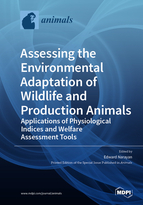Assessing the Environmental Adaptation of Wildlife and Production Animals: Applications of Physiological Indices and Welfare Assessment Tools
A special issue of Animals (ISSN 2076-2615). This special issue belongs to the section "Wildlife".
Deadline for manuscript submissions: closed (2 December 2020) | Viewed by 58306
Special Issue Editor
Interests: animal welfare; conservation biology; conservation physiology; neuroendocrinology; production animal health and welfare; reproductive health; stress; immune system; zoology
Special Issues, Collections and Topics in MDPI journals
Special Issue Information
Dear Colleagues,
Wild animals under human care as well as domesticated farm production animals are often exposed to environmental changes (e.g., capture and transportation). Short-term or acute changes in physiological indices (e.g., heart rate, respiration, body temperatures, immune cells and stress hormonal biomarkers) provide crucial information regarding the responses of animals to novel environments, and they could provide crucial determining factors for the long-term health and welfare of animals. This Special Issue welcomes experimental research papers that demonstrate the applications of physiological indices and welfare assessment methods (e.g., morphological and morphometric data, behavioural assessments, thermal profiles, and physiological markers) in any wildlife or production animal (e.g., rescued and rehabilitating animals, pets, competition animals, farm animals and zoo animals), in response to environmental and management related factors. The goal is to provide examples of new research and techniques that can be used to monitor short- and long-term environmental adaptation of animals under human care.
Dr. Edward Narayan
Guest Editor
Manuscript Submission Information
Manuscripts should be submitted online at www.mdpi.com by registering and logging in to this website. Once you are registered, click here to go to the submission form. Manuscripts can be submitted until the deadline. All submissions that pass pre-check are peer-reviewed. Accepted papers will be published continuously in the journal (as soon as accepted) and will be listed together on the special issue website. Research articles, review articles as well as short communications are invited. For planned papers, a title and short abstract (about 100 words) can be sent to the Editorial Office for announcement on this website.
Submitted manuscripts should not have been published previously, nor be under consideration for publication elsewhere (except conference proceedings papers). All manuscripts are thoroughly refereed through a single-blind peer-review process. A guide for authors and other relevant information for submission of manuscripts is available on the Instructions for Authors page. Animals is an international peer-reviewed open access semimonthly journal published by MDPI.
Please visit the Instructions for Authors page before submitting a manuscript. The Article Processing Charge (APC) for publication in this open access journal is 2400 CHF (Swiss Francs). Submitted papers should be well formatted and use good English. Authors may use MDPI's English editing service prior to publication or during author revisions.
Keywords
- welfare
- physiology
- immune function
- metabolism
- behaviour
- fitness
- body condition
- reproduction
- health
- survival
- zoos
- farms
- rescue and rehabilitation
- veterinary assessment







